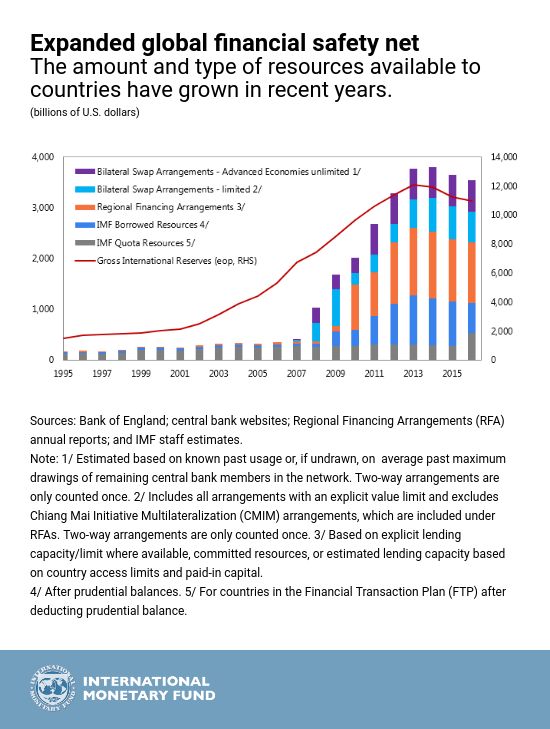If you are lucky, when the going gets tough, you have a group of people you can rely on to help you through a crisis. Countries are no different—a safety net to help them in bad economic and financial times can make the difference in peoples’ lives.
Insurance against crises
The global financial safety net should help countries in three ways: provide insurance to help prevent crises; supply financing to countries if crises materialize; and provide incentives for countries to adopt the right policies.
Here is a quick breakdown of the safety net. It has four main layers:
- countries’ own reserves;
- bilateral swap arrangements between two countries;
- regional financing arrangements; and
- the IMF.
All these layers have expanded over the past 20 years.
The safety net expands
The last few decades have seen vast changes in the structure of the global economy. For example, emerging market economies like China, India, and Brazil now account for 60 percent of global GDP.
Countries’ economies are more connected to one another than ever, and so are more exposed to the ups and downs of global economic opportunities and misfortunes, and they all need a safety net when the economic tides turn.
The IMF is always learning, fine tuning, and upgrading how it can help countries, and the global financial safety net is one way the IMF and many others help countries protect global economic stability.
Since 2000, global reserves have increased from around $2 trillion to $11 trillion. At the IMF, quota resources have doubled to about $670 billion, and since the crisis member countries have made available substantial additional borrowed funds that the IMF could use if needed.
On top of these layers, some countries also have bilateral swap and regional financing arrangements, whose relative role has increased dramatically over the last decade.
Bilateral swap arrangements between countries are comprised mainly of two separate networks:
- unlimited permanent swaps between the central banks of some of the major reserve currency-issuing countries; and
- an extensive network of swaps between China and other countries, worth around $500 billion, to support trade and investment.
During the global financial crisis, some countries also extended temporary swap lines to other advanced economies and emerging market economies, but these have since expired.
The expansion of regional financing arrangements has been no less striking. Countries have established new arrangements and have increased the resources of existing ones. In particular, euro area countries established the permanent European Stability Mechanism with a lending capacity of €500 billion to help resolve crises.
In Asia, countries turned the Chiang Mai Initiative into a multilateral one, and doubled the amount of available funding to $240 billion.
Also, Brazil, Russia, India, and China established a multilateral Contingent Reserve Arrangement worth $100 billion.
Bridging the gaps
Even with all this expansion, gaps remain. In 2016, the IMF analyzed the health and coverage of the existing global financial safety net, and produced a diagnosis that identifies shortcomings.
- Coverage is uneven, with many countries, including key emerging markets, lacking adequate access to funding. Financing can also be uncertain for countries needing to tap newly expanded layers that have yet to be drawn upon.
- Most layers lack adequate conditions for borrowing, which can weaken the incentives for countries to adopt strong policies.
- Some layers of the safety net can also be financially or political costly for borrowing countries, or for the global community as a whole, notably in the case of excessive self-insurance through reserves.
The IMF is always looking for ways to improve how it serves its 189 member countries, and its work to strengthen the global financial safety net is no exception. With this is mind, we have been working on improving our lending toolkit, including developing a proposal for a new short-term liquidity swap, which could serve as a blueprint for such a facility in the future, if and when there is sufficient support.
The IMF also updated the rule book for its Flexible Credit Line, and the Precautionary and Liquidity Line, to make the process for countries to qualify more predictable and transparent.
We also rolled out a new Policy Coordination Instrument to help countries unlock financing from different layers of the safety net, particularly regional financial arrangements, and demonstrate their commitment to reform. The first policy coordination instrument was approved for Seychelles on December 13.
The IMF has published a paper on improving collaboration with regional financial arrangements, setting out principles and a framework for engagement. We have also participated in a test-run with the Chiang Mai Initiative Multilateralization, which identified possible refinements that could help to smooth co-lending.
The global economy continues to evolve at a rapid pace: blockchain and venmo weren’t even words a few years ago. The rate of change and innovation means we need to stay agile and build a better safety net that keeps its many strands closely connected, coordinated, and focused on countries’ needs.


